In line with the saying “the way to a man’s heart is through his stomach”, promoting companies often opt for sweet messengers to reach their target groups. But what if the people with a sweet tooth bite on a piece of metal instead of a soft fruit gum? Or their throats swell up because there are traces of nuts in the contents? A look behind the scenes at Kalfany Süße Werbung shows how this can be reliably prevented so that trouble and bitter image losses are avoided.
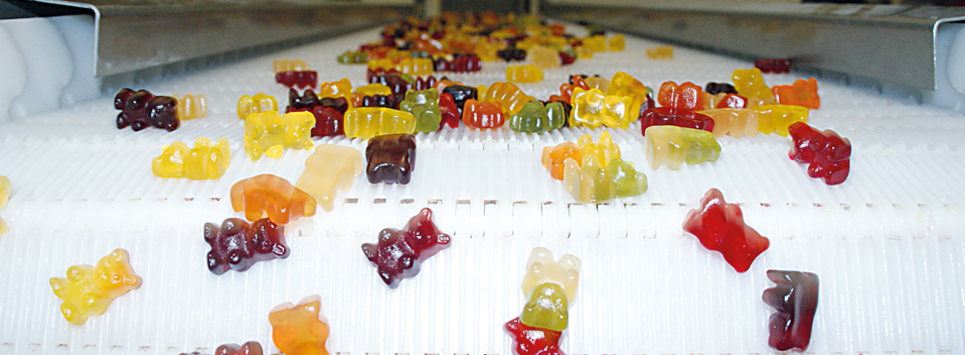
The T-shirt is washed before being worn the first time, the slightly dusty cup rinsed before the first coffee is poured. And the bag of jelly babies? It is gobbled down without beating about the bush. Here, the company that places the item onto the market has to take all the precautionary measures to prevent the consumer from coming into contact with harmful substances or impurities. After all, the ready-to-eat sweets are supposed to be just that – ready for carefree enjoyment.
Klaus Richter, CEO, and Anastasia Miller, part of the four-member quality management team at Kalfany Süße Werbung know everything that has to be done to present companies with high-quality safe-to-eat messengers. The products and the fruit gum specialities of the manufacturer that belongs to the Zertus Group, are IFS-certified (International Featured Standards) so they comply with the highest quality demands. The company that is located in Herbolzheim and the neighbouring town Müllheim, in South Germany, is present on the food retail market with its own brands and exclusively supplies the promotional products market with the products of Mars, Ferrero or Dextro Energy. The observance of the IFS provisions is a prerequisite for the handling, packaging and customising of the brand items. “So that the customer comes back rather than the goods, all processes within our company – from the procurement of the raw materials, to the manufacturing and packaging, through to the dispatch – are subject to strict regulations and controls,” confirmed Richter. In addition to the daily hygiene checks, quarterly external factory audits, internal quality controls as well as inspections by the supplier partners such as Mars and co., annual IFS audits are also carried out by the SGS-certified Fresenius Institute.
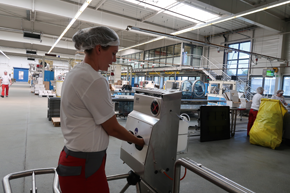
So that nobody can enter the production department without disinfecting their hands, the safety door only opens once the disinfection machine has been used.
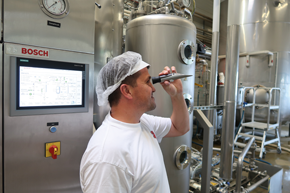
The share of dry substance within the sugar mass is tested in the refractometer.
Whether classic jelly babies, sour Cola bottles, exotic vegan fruits or the Black Forest cherry dessert – each of the approx. six million fruit gums produced per shift is made using the same method: The mass comprising of glucose, granulated sugar, gelatine or plant-based gelling agents and water is cooked and subsequently enriched with fruit juice, aromas and natural colourants. The mass is made into bears, hearts and co, using a moulding process, i.e. it is poured into wooden boxes filled with corn starch. Corresponding troughs are previously created using individual moulds – Kalfany holds around 2,400 different moulds in stock, including their own as well as customer-specific moulds. The fruit gums then pass through into the drying room, where – depending on their size and weight – they harden while being kept under a constant temperature and humidity conditions for 24 to 96 hours. The goods are transported from the production to the packing department in big bags so that impurities are avoided en route, before they are packed into individualised flowpacks.
Of course, all machines used for the production as well as all cleaning and maintenance materials, packaging, customising process and the storage have to be food-safe and IFS-compatible. Miller explained the effort that the safety precautions and their monitoring entail: “For the fruit gum production alone all of the production processes, including personal hygiene, protective clothing, observance of the ingredients and the traceability of the raw materials and packaging have to be assessed during the IFS audit. Furthermore, we have to document the production comprehensively and seamlessly. A sample and the completely documented procedure have to be available for each individual batch manufactured.” To this purpose, all of the materials used such as aromas, colourants or films have a batch number. In this way, in the event of a complaint by the ordering company, it is immediately transparent which ingredients were used.
Forewarned is forearmed
The systematic risk analysis following the HACCP concept (Hazard Analysis and Critical Control Points) is part of the IFS audit – and has been prescribed by law in the EU for all foodprocessing factories since 2006. It involves each production phase being checked for all possible impairments by a multi-disciplinary team. “In order to avoid unintentional changes, we analyse which risks there are for each production phase of each item and how these can be prevented. The biological factors include among others germs that can find their way into the production for instance due to the hygiene regulations being violated. Chemically speaking, the mass can be contaminated among other things due to remnants of cleaning agents and physically for example in the form of metal splinters caused by the abrasion of machines. Allergens are also factors that we have to take into account,” stated Miller. For the team this means that the critical control points have to be defined, the measures determined that are to be introduced to minimise or rule out the respective risk – the effect and probability of the pollution determine here the priority of the actions to be carried out. For example, a metal detector is interconnected to detect metal splinters before they are accidently consumed. And if it is not avoidable that minimum amounts of highly allergen substances such as peanuts end up in the ingredients, the label has to be changed and the corresponding statement such as “can contain traces of peanuts” has to be printed on it.
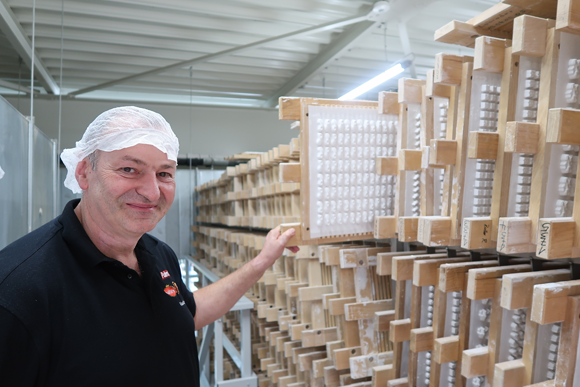
Klaus Richter proudly presenting one of 2,400 fruit gum moulds.
Because company responsibility also plays an important role in the IFS audit, the management is always kept up-to-date regarding quality management and is involved in the processes. For instance the so-called “HACCP flow charts”, which illustrate the control points for each production phase of each recipe have to be signed off and approved by the management before they can be used. Furthermore, “Food defence”, product protection, has become increasingly more relevant in food production over the last years and is meanwhile also part of the audit. “Around two years ago we fenced the entire grounds off so that we can monitor access to the company and can stop unauthorised persons from entering,” explained Richter. In this way, in addition to unintentional strains on the sweets through mechanical abrasion or lacking employee hygiene, Kalfany also avoids intentional contamination by saboteurs or thieves. Warehouse employees are given special training and check for instance when the raw materials arrive that the order number is registered or whether the items were really ordered. “Furthermore, the quality management department decides on the further procedure in each individual case, for example if the seals are missing on the containers, the goods arrive contaminated or damaged,” added Miller.
An eye for detail
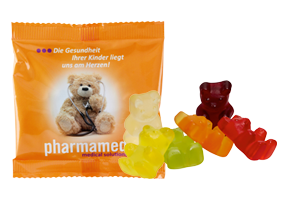 One of the most frequent operations in the daily workflow underlines how meticulously the team has to act – the checking and countersigning of processes. Not any old ballpoint pen is allowed to be used here, namely apart from having to wear protective clothing and clean and disinfect one’s hands constantly, a main focus lies on items the employees are carrying with them, which lose small parts or could spread germs. The specially made ballpoint pen is exceptionally robust, it is almost impossible to break off the clip or pusher. And should this actually happen, the plastic of the model contains traces of metal so that the bits are found by the metal detector – at the latest prior to the goods sealed inside flowpacks being dispatched. Kalfany also takes special precautionary measures here to ensure high quality and maximum safety: The ready loaded palettes are not secured using see-through stretch film, but instead with film dyed blue. If the delivery arrives in normal film, one recognises immediately that it has been repacked and thus possibly damaged along the way. The transport is taken care of by logistics partners, who are also IFS-certified.
One of the most frequent operations in the daily workflow underlines how meticulously the team has to act – the checking and countersigning of processes. Not any old ballpoint pen is allowed to be used here, namely apart from having to wear protective clothing and clean and disinfect one’s hands constantly, a main focus lies on items the employees are carrying with them, which lose small parts or could spread germs. The specially made ballpoint pen is exceptionally robust, it is almost impossible to break off the clip or pusher. And should this actually happen, the plastic of the model contains traces of metal so that the bits are found by the metal detector – at the latest prior to the goods sealed inside flowpacks being dispatched. Kalfany also takes special precautionary measures here to ensure high quality and maximum safety: The ready loaded palettes are not secured using see-through stretch film, but instead with film dyed blue. If the delivery arrives in normal film, one recognises immediately that it has been repacked and thus possibly damaged along the way. The transport is taken care of by logistics partners, who are also IFS-certified.
The positive audit results that can be viewed on the company’s homepage demonstrate that caution pays off. “Our aim is that customers explicitly keep their eyes out for high-quality goods. The image of promotional sweets and with it also the image of the promoting companies benefits from this too,” stressed Richter. For the target group this means: Simply rip open the bag and get stuck in.
// Claudia Pfeifer
Photos: Claudia Pfeifer (3), © WA Media GmbH; Kalfany Süße Werbung (2); Shutterstock/Kostsov (1); Shutterstock/matthew25 (1)
IFS
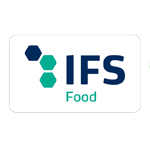 The IFS quality seal was developed in 2003 especially for the food industry as the “International Food Standard”, in the meantime the generic term “International Featured Standards” encompasses diverse food, product and service standards. The IFS food standard distinguishes manufacturers or food-processing companies that satisfy the highest quality demands across all corporate areas such as quality and resource management, the production process as well as various analysis and optimisation methods. For example manufacturers, who would like to introduce their own brand products onto the food retail market, have to prove that their products comply with the IFS standard. A further element of IFS Food is the “Good Manufacturing Practice”, which additionally demands hygiene regulations and efforts involving cleaning, disinfecting, maintenance, service or training, as well as the HACCP (Hazard Analysis and Critical Control Points concept), which guarantee the safety of food and the consumers. The consistent observance or optimisation of the standard is checked once a year by accredited institutes like Intertek, Bureau Veritas, TÜV or SGS. Points are awarded during the audit – the scoring system makes the comparison to previous years and decisions regarding necessary improvement measures easier.
The IFS quality seal was developed in 2003 especially for the food industry as the “International Food Standard”, in the meantime the generic term “International Featured Standards” encompasses diverse food, product and service standards. The IFS food standard distinguishes manufacturers or food-processing companies that satisfy the highest quality demands across all corporate areas such as quality and resource management, the production process as well as various analysis and optimisation methods. For example manufacturers, who would like to introduce their own brand products onto the food retail market, have to prove that their products comply with the IFS standard. A further element of IFS Food is the “Good Manufacturing Practice”, which additionally demands hygiene regulations and efforts involving cleaning, disinfecting, maintenance, service or training, as well as the HACCP (Hazard Analysis and Critical Control Points concept), which guarantee the safety of food and the consumers. The consistent observance or optimisation of the standard is checked once a year by accredited institutes like Intertek, Bureau Veritas, TÜV or SGS. Points are awarded during the audit – the scoring system makes the comparison to previous years and decisions regarding necessary improvement measures easier.
HACCP
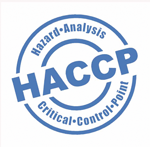 The Hazard Analysis and Critical Control Points concept serves to analyse the risks during the production and handling of food in order to safeguard its carefree consumption. It has been prescribed by law in the EU since 2006. All factors that could affect the purity of the food, have to be recognised and the corresponding countermeasures determined in order to assure the health of the consumers. After the precise definition of all production steps, all possible risks have to be listed as well as the critical control points, where the risk can occur. Subsequently the control measures and their monitoring as well as a system for correcting errors and control tests have to be determined. Biological, chemical and physical factors can influence the food. Their effects, the probability of them happening and the detection in the factory determine the risk priority index which indicates the urgency of the countermeasures.
The Hazard Analysis and Critical Control Points concept serves to analyse the risks during the production and handling of food in order to safeguard its carefree consumption. It has been prescribed by law in the EU since 2006. All factors that could affect the purity of the food, have to be recognised and the corresponding countermeasures determined in order to assure the health of the consumers. After the precise definition of all production steps, all possible risks have to be listed as well as the critical control points, where the risk can occur. Subsequently the control measures and their monitoring as well as a system for correcting errors and control tests have to be determined. Biological, chemical and physical factors can influence the food. Their effects, the probability of them happening and the detection in the factory determine the risk priority index which indicates the urgency of the countermeasures.



